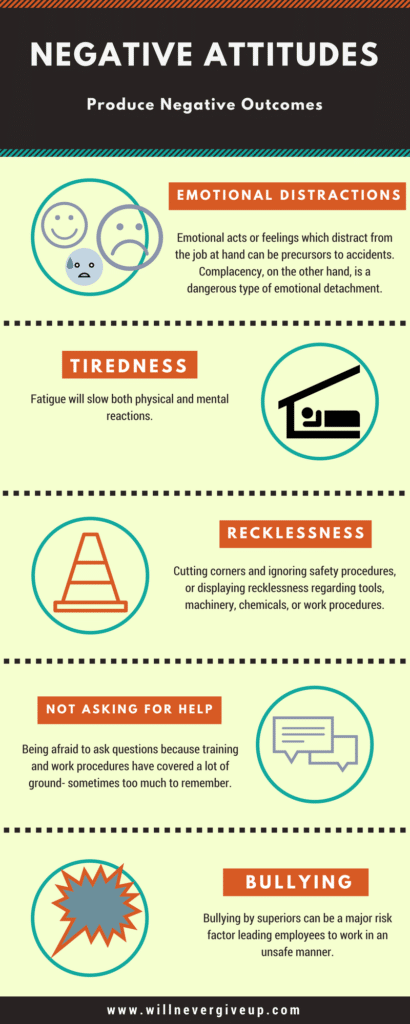A workplace safety attitude refers to an employee’s tendency to respond positively or negatively towards a safety goal, idea, plan, procedure, prevention or situation.
It’s a fact that your work attitude not only affects how well you do your job, but also affects how safe you are when you’re doing it. Attitude could be described as the spark that drives your behaviour.
Your attitudes are made up of:
- Emotions or feelings which are driven by your mental state at any particular time
- Your beliefs or opinions derived from your faith or upbringing
- Your inclination (or not!) for action, usually driven by your opinions
- Your positive or negative response to stimuli, giving rise to your actions
If you have a generally positive attitude, you tend to derive a great deal of satisfaction from your life and your work. Positive people seldom give up. They usually perform well in the workplace because they are motivated to maintain an open mind, are receptive to new ideas, pay attention to details and consider the possible outcomes of the ways in which they act. They develop safe work habits because, among other things, they are always looking for ways to improve.
On the other hand, people with negative attitudes complain about everything, including having to practice safety. They are less likely to care about the desired quality of the job to be done or how they will do it. A negative work attitude can lead to unsafe work habits and accidents. It becomes all too easy to ignore the safety precautions that keep workers safe, thereby putting them at risk.
A negative attitude closes individuals down and makes them lose interest or display little pride in their work. Their actions become self-limiting. Many workplaces are characterised by negative attitudes, and in general, it’s a real problem, but when that negative attitude is applied to workplace safety it can lead to disaster. At the very least, there will be an increase in production costs, turnover rates, and a reduction in employee safety, morale, quality, profitability and business goodwill.
There are many reasons why bad safety attitudes exist. Broadly speaking, carelessness is the biggest cause of accidents. Mishaps happen when workers have negative attitudes.

New and inexperienced workers are often the ones particularly vulnerable to risk, as a lack of experience with the consequences of risks can lead to overconfidence. It also takes time to develop the skills of dexterity, understanding of tools and problem-solving abilities needed to work safely without supervision. Add to this a susceptibility to negative peer influence, e.g. learning to see near misses as a ‘laugh’, fear of speaking up, and a lack of good role models of safe behaviour, and it’s no wonder that our new and inexperienced workers are often the ones most at risk of workplace accidents.
This article originally published by INX Software, 26 June 2018.

Doug Wright is a transformed survivor of a head-on near-death vehicle collision. Passionate about helping people overcome their innermost fears, especially when recovering from trauma, Doug has survived to share his courageous story… his motto is “never give up”. Away from his everyday activities, Doug invests his spare time playing his electric guitar, knocking out an eclectic mix of Eagles hits and fishing for coral trout in Airlie Beach, Northern Queensland.


